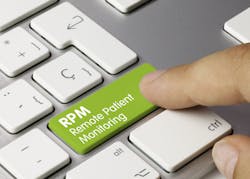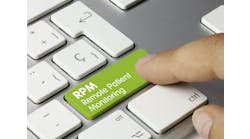Remote therapeutic monitoring (RTM) has become a subject of great interest to many orthopedic surgeons across the U.S.
Centers for Medicare and Medicaid Services issued new CPT codes last year to reimburse for remote monitoring of musculoskeletal (MSK) and respiratory care patients.
RTM refers to the use of patient-reported non-physiological data to monitor patients’ overall health and response to treatment, including patient-reported outcomes, such as form scores, pain, therapy plan adherence, medication adherence, and other metrics.
Importantly, RTM does not require a medical device to be supplied to patients, because it is focused exclusively on patient-reported data. Instead, data is recorded through digital patient management solutions, which must satisfy Food and Drug Administration requirements for software as a medical device to support reimbursement using the new CPT codes. Patients can interact on smartphones, websites, or via text messaging.
In addition to representing a new revenue stream for providers, RTM is generating interest for its ability to improve patient engagement, satisfaction, care quality, and outcomes, as well as reduce costs for both patients and providers.
A better way of delivering post-surgical care. Orthopedic Institute Brielle Orthopedics is part of New Jersey’s largest and most prominent orthopedic group. As a partner and orthopedic surgeon with the practice, I specialize in total joint replacement, including primary, complex, and revision total hip and knee replacements as well as robotic and computer-assisted surgeries.
In the past, I felt frustration due to our limited ability to track patient progress during post-surgical recovery. Traditionally, we lacked direct and continuous visibility into patient recovery, relying instead on just a few patient interactions to understand post-surgical quality of life and potential issues.
Additionally, standard post-surgery care protocols were too time-consuming and burdensome for patients, requiring them to complete numerous forms in-person, take home large amounts of overwhelming educational materials, and participate in multiple sessions of costly outpatient or home-based physical therapy.
This diminishes the effectiveness of post-surgical care. For example, research from Brown University has shown that patients remember only about one-half of the information their doctors give them without prompting.
These shortcomings often represent a gap in patient care, leading to adverse events such as readmissions and emergency department (ED) visits, and incurring unnecessary costs on the health system – for providers, payers, and patients alike.
To overcome these drawbacks, our practice began using digital tools, but we found them to be limited. I took the lead to vet potential technology solutions that addressed a wider range of capabilities, including RTM. Specifically, we sought a solution that would:
● Deliver timely virtual education, physical therapy, and care instructions
● Monitor patient progress and compliance through population health management tools
● Maintain direct communication, averting costly events such as readmissions and ensuring urgent care when needed
● Collect patient-reported outcomes remotely with high engagement
● Identify and enroll eligible RTM patients and utilize RTM capabilities to record monitoring time and streamline billing
Digital tools to augment the care journey. Since implementing the new platform, our providers have been able to engage patients better than ever before, with the platform automating tracking of non-physiological patient-reported outcomes, such as quality-of-life data, pain levels, and range of motion. Patients are required to engage with the platform by accessing educational content, such as virtual physical therapy videos or care instructions, and providing patient-reported outcomes a minimum number of days per month.
We have found that augmenting patients’ care journeys with digital tools also boosts patient satisfaction, by providing them with a library of easily digestible and sharable resources they can access anytime, anywhere, and as many times as they want. As patients participate in these educational and exercise activities, they become more engaged in their own care and often enjoy tracking their own progress against goals. By helping patients better understand their surgeries and recovery, our practice can produce better health outcomes.
Additionally, we have seen numerous benefits from a financial perspective associated with adopting the RTM platform. In the first five months, we received more than $33,000 in RTM reimbursement from both public and commercial payers for 158 patients alone. Most importantly, we have identified annual cost savings of up to $1 million for our practice, and up to $2 million across the care ecosystem.
Much of that savings stems from the ability to work so closely with our patients that we are able to spot signs of deterioration earlier and intervene immediately. By helping to avoid even a small number of ED visits and readmissions, we estimate a savings of an average of $10,000 per patient.
Further, by replacing paper-based, manual, and in-person processes for preoperative care with digital tools, we save $1,400 per patient. Because the digital process is easier for patients, they are more reliably completing their pre-surgery activities and preparation, enabling us to avoid last-minute cancellations and reschedules, which cost about $3,000 per patient.
Finally, the efficiency gains we’ve experienced using the Force Therapeutics platform to provide smart remote care and enable RTM have helped us increase patient volume by an estimated 30 percent, driving greater revenues and relieving patient-access issues.
When used appropriately and in tandem with a holistic digital care approach, RTM can be a powerful tool for providers to more frequently and regularly monitor patient-reported outcomes and metrics, enabling more targeted care for those who need it, and producing consistent and standardized outcomes across patient populations.
Ahmed Siddiqi, D.O., MBA, is an orthopedic surgeon at Orthopedic Institute Brielle Orthopedics in New Jersey.

